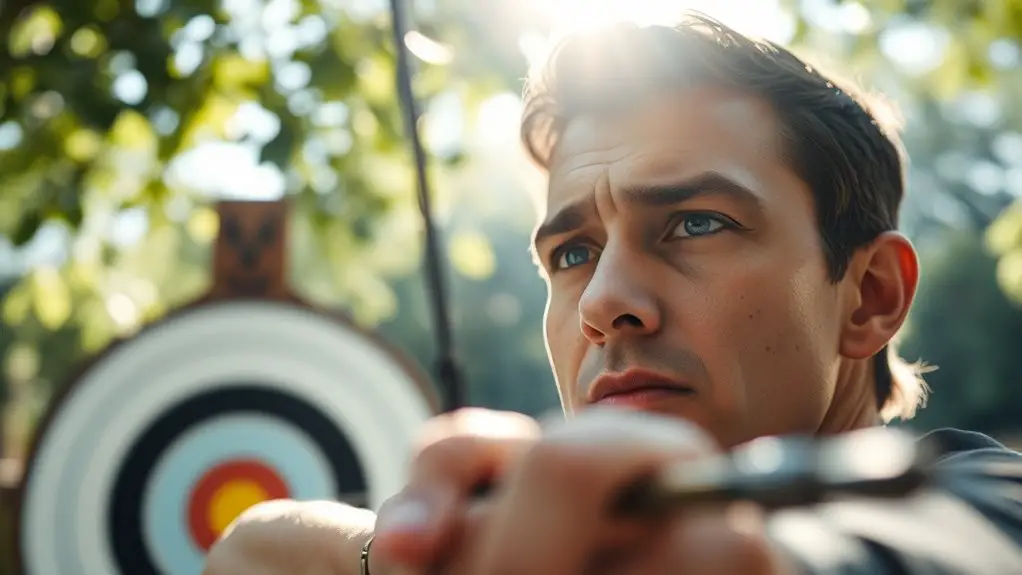To achieve stable aiming, focus on key breathing techniques. Diaphragmatic breathing helps ground you and promotes calmness. Try the 4-7-8 technique to enhance focus by regulating your breath rhythm. Box breathing is great for managing your heart rate during tense moments. Remember, synchronizing breath control with your trigger pull is essential for accuracy. By integrating these practices into your routine, you'll improve your aiming performance noticeably. Curious about more techniques? There's plenty more to explore.
Diaphragmatic Breathing: The Foundation of Stability
When you aim, mastering diaphragmatic breathing can greatly enhance your stability. This technique focuses on diaphragm engagement, allowing you to draw in deep, full breaths that ground you. As you inhale, let your abdomen expand, filling your lungs with air. This not only calms your mind but also promotes stability improvement in your stance.
The 4-7-8 Breathing Technique: Enhancing Focus
Building on the foundation of diaphragmatic breathing, the 4-7-8 breathing technique offers a structured approach to enhance focus. This method involves inhaling for four seconds, holding your breath for seven, and exhaling slowly for eight. By practicing this technique, you'll find yourself entering a state of calm, allowing for significant focus enhancement during your aiming activities.
When you incorporate the 4-7-8 technique into your routine, you'll notice a reduction in anxiety, freeing your mind from distractions. The rhythm of your breath not only stabilizes your body but also sharpens your mental clarity. As you practice, you'll develop a greater sense of control over your thoughts, making it easier to concentrate on your target.
Box Breathing: Regulating Your Heart Rate
While many techniques can enhance focus, box breathing stands out as a powerful method for regulating your heart rate. This structured breathing technique helps you find calm amid chaos, making it ideal for moments that demand precision.
To practice box breathing, inhale deeply through your nose for four counts, hold for four counts, exhale through your mouth for four counts, and pause for another four counts. Repeat this cycle a few times, and you'll notice your heart rate slowing, which is essential for stress management. Additionally, incorporating breathing techniques into your routine can lower heart rate and enhance focus, further supporting your ability to perform under pressure.
As you focus on your breath, you're not just calming your heart rate; you're also freeing your mind from distractions. This sense of control can empower you, allowing you to aim with unwavering confidence. Embrace box breathing, and you'll discover a new level of clarity, paving the way for more stable aiming and improved performance in any situation.
Breath Control During Trigger Pull: Timing Is Key
Mastering breath control during the trigger pull can greatly enhance your accuracy. When you're aiming, it's vital to practice breath synchronization. As you settle into your stance, take a deep breath, filling your lungs fully. Hold that breath for a moment as you align your sights. This pause creates a calm window, allowing your body to stabilize. Just before the trigger release, gently exhale, letting the air flow out slowly. Timing is key here; releasing the trigger on an exhale guarantees minimal movement, maintaining your aim.
If you rush this process, you might introduce unnecessary tension. Instead, embrace the rhythm of your breath. With each shot, refine your ability to coordinate your breathing with your trigger pull. This not only frees you from distractions but also empowers your aim. By mastering this technique, you're not just shooting; you're embracing precision and control.
Incorporating Breathing Techniques Into Your Practice Routine
To effectively incorporate breathing techniques into your practice routine, start by establishing a consistent framework. Integrate breathing exercises that resonate with your personal style, allowing you to feel free and focused. Aim for practice consistency by dedicating time to these exercises during each session.
Here's a simple table to guide you:
| Breathing Technique | Description |
|---|---|
| Diaphragmatic Breathing | Engages the diaphragm for deeper breaths. |
| Box Breathing | Inhale, hold, exhale, hold for equal counts. |
| 4-7-8 Breathing | Inhale for 4, hold for 7, exhale for 8 seconds. |
| Equal Breathing | Inhale and exhale for equal lengths. |
Frequently Asked Questions
Can Breathing Techniques Improve Overall Shooting Performance?
Absolutely, breathing techniques can enhance your shooting performance considerably. When you're focused on your breath, you're not just calming your body, but also sharpening your mental focus. This clarity can lead to improved shooting accuracy as you align your aim and release. By taking control of your breath, you're embracing the freedom to perform under pressure, allowing you to shoot more consistently and confidently. So, why not give it a try?
How Long Should I Practice These Techniques Daily?
Practicing breathing techniques is like tuning a musical instrument; a little daily commitment can lead to harmony in your performance. Aim for at least 10 to 15 minutes each day to see progress. Consistency is key, so carve out this time for yourself. Just as you wouldn't expect a symphony without practice, you can't rush mastery. Make it a part of your routine, and enjoy the freedom that comes with improved focus and stability.
Are There Any Risks Associated With Improper Breathing Practices?
When it comes to breathing practices, you should definitely consider breathing safety. Improper techniques can lead to health risks like hyperventilation, dizziness, or even anxiety. If you're not mindful, you might find yourself feeling more tense, which defeats the purpose of your practice. It's crucial to stay relaxed and focused, so always pay attention to how your body responds. Embrace freedom in your techniques, but don't ignore safety in the process!
Can Breathing Techniques Be Applied to Other Sports?
When it comes to sports performance, you can definitely breathe easy! Breathing techniques, like those found in yoga breathing, can enhance your game across various sports. Whether you're running, swimming, or playing basketball, proper breathing helps you stay focused and calm under pressure. By incorporating these techniques, you'll find yourself hitting the ground running, improving your endurance and concentration. So, why not take a deep breath and elevate your performance?
What Are Signs That I'm Not Breathing Correctly?
If you're questioning your breathing patterns, pay attention to signs like tightness in your chest, feeling lightheaded, or fatigue. These indicate you might not be breathing correctly. Developing breath awareness is essential; notice if you're taking shallow breaths or holding your breath unknowingly. Freedom in your performance comes from relaxed, steady breathing. By recognizing these signs, you can enhance your overall experience and achieve a more fluid, enjoyable flow in your activities.




